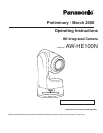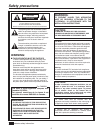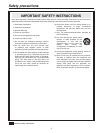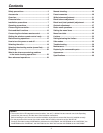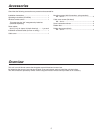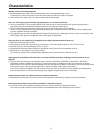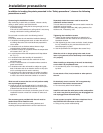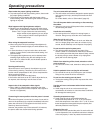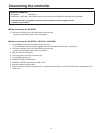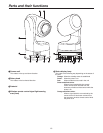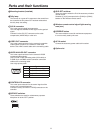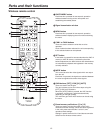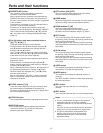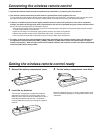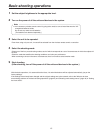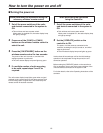
8
Operating precautions
Shoot under the proper lighting conditions.
T
o produce pictures with eye-pleasing colors, shoot under
the proper lighting conditions.
The pictures ma
y not appear with their proper colors
when shooting under fluorescent lights. Select the proper
lighting as required.
What happens with high-brightness subjects
Shooting v
ery bright objects may give rise to the smear
effect, which is a phenomenon inherent to CCD cameras.
Smear
: This is a type of distortion characterized by
bright vertical stripes appearing on very bright
or shiny subjects, which include light bulbs or
incandescent lamps.
When using the automatic functions
When using the A
TW (auto tracking white adjustment)
function under fluorescent lights, the white balance may
vary.
In some situations
, it may be hard to focus at the auto
setting. In cases like this, select the manual setting, and
focus manually.
The appropr
iate brightness may not be obtained when
shooting bright objects using the auto settings for the
gain and iris. In cases like this, set the shutter speed to
manual, and adjust.
Zooming and focusing
When the focus is set to manual, the subject may go out
of focus during zooming. Therefore, the unit comes with a
function which compensates for this. (Focus compensation
during zooming function)
This function was set to ON at the factory.
If the function has been set to OFF, either adjust the focus,
as required, after zooming or set the focus to auto.
Aspect ratio of the composite video signals
When 1080i or 7
20p has been selected as the video
format, the aspect ratio of the composite video signals is
fixed at 16:9 (squeeze).
Concerning the zoom position when the power is turned
on
When the unit’s power is turned on, the zoom, focus and iris
return to the positions they occupied immediately before the
power was turned off. (This happens for the focus and iris
when they were set manually.)
However, this position may not be restored if, for instance,
the power cable was disconnected during operation.
The unit comes with safe modes.
The saf
e modes are functions designed to protect people
and property from injury and the pan-tilt head unit from
damage.
For further details, refer to “Safe modes” (page 55).
Turn off the power before connecting or disconnecting
the cables.
Alw
ays be sure to turn off the power before connecting or
disconnecting the cables.
Handle the unit carefully.
Do not drop the unit or subject it to strong impact or
vibr
ation. Doing so may cause the unit to malfunction.
When the unit is not in use
T
urn off the unit’s power when it is not in use. When the
unit is no longer going to be used, do not leave it lying
around, but be absolutely sure to dispose of it properly.
Do not touch the optical system parts.
The optical system par
ts are the very heart of the
camera. Under no circumstances must they be touched.
In the unlikely event that they have become dusty, remove
the dust by using a camera blower or by wiping them
gently with a lens cleaning paper.
Refrain from attaching a filter, hood, extender or other
parts to the unit.
Do not mount a filter
, hood, extender or other parts on the
unit.
Hold the pedestal when carrying the unit around.
Do not hold the unit b
y its camera part or pan-tilt head.
Doing so may cause the unit to malfunction.
Do not turn the rotating parts by hand.
T
urning the rotating parts by hand may cause the unit to
malfunction.
Use the unit in an environment with minimal moisture
and dust.
A
void using the unit in an environment with high
concentration of moisture or dust since these conditions
will damage the internal parts.
Operating temperature range
A
void using the unit in cold locations where the
temperature drops below 32 °F (0 °C) or hot locations
where the temperature rises above 104 °F (+40 °C) since
these temperatures downgrade the picture quality and
adversely affect the internal parts.
Disposal of the unit
When the unit has reached the end of its ser
vice life and
is to be disposed of, ask a qualified contractor to dispose
of the unit properly in order to protect the environment.



